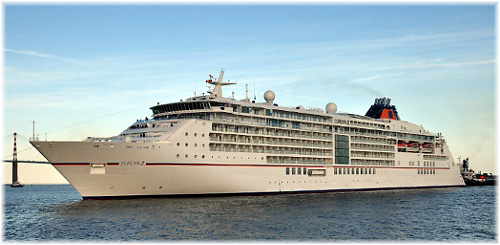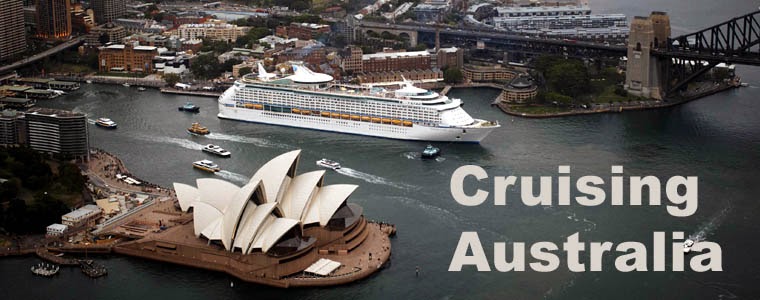 by Kevin Griffin
by Kevin GriffinThis week we have a look at the latest order for Holland America Line’s first “Pinnacle” class vessel in comparison to other ships, particularly the line’s own “Signature” class ships Eurodam and Nieuw Amsterdam, their competitor’s “Celebrity Equinox” class, and the “Costa Luminosa” class, the basic platform of which will apparently be used in the new design. Elsewhere, we have a look at an impending change of marketing policy at Hapag-Lloyd Cruises and the takeover of Germany’s TransOcean Cruises by UK-based Cruise & Maritime Voyages.
THIS WEEK’S STORY
Holland America’s New “Pinnacle” Class
Beyond the names of the interior designers, no new information has yet been released on the first of Holland America Line’s new “Pinnacle” class ships, although images have been floating around the Internet for some months now. Originally ordered from Fincantieri in October 2012, along with a 4,000-passenger vessel for sister brand Carnival Cruise Lines, for delivery in 2015, the Holland America ship has now been delayed until mid-February 2016.

Holland America’s new “Pinnacle” Class ship
With a beam of 115 feet, she would not be able to transit the present Panama Canal locks but she will be able to transit the new wider locks that are now under construction.
This new class of ship will measure 99,700 tons and have 2,660 berths, within striking range of arch-competitor Celebrity Cruises’ 2,850-berth “Equinox” class.
According to sources, while being larger versions of the “Signature” class vessels Eurodam and Nieuw Amsterdam, the new Holland America design is actually based on the platform of the 92,720-ton “Costa Luminosa” class, although with a lower passenger space ratio (the measure of gross tons volume per passenger).
The hull has been lengthened and widened, two more decks added forward and certain other changes made, including lowering the lifeboats, the elimination of the atrium in the Costa design and the relocation of the Tamarind Restaurant from a forward position on the “Signature” class to one aft on the new “Pinnacle” ship.
The relevant comparisons are:

While the lower PSR follows recent industry-wide trends for mainline ships to dip below 40, this ratio does not compare well with her predecessors (it is a reduction of almost 13% on the “Signature” class), nor with the “Celebrity Equinox” class (12% less space per guest on HAL) nor even the “Costa Luminosa” class (8.5% less).

Statendam – Holland America Line
These ships have been so successful that all six are still in service with their original owners two decades later.
Meanwhile, a new interior designer for Holland America, Adam Tihany, has joined Bjorn Storbraaten, who designed the public rooms for Holland America Line’s “Signature” class, to ensure that the new “Pinnacle” class will meet the expectations of previous Holland America Line clients, some of whom are questioning whether the new ship, with 25% more berths, will be one step too far in terms of size for Holland America.

Celebrity Equinox
As it happens, the “Pinnacle” class capacity is also within 40 berths of that most famous of existing ships, the 2,620-berth Queen Mary 2, although with a tonnage of 148.528, the Queen Mary 2 offers a very generous 56.7 tons per passenger, more than half as much again as the new “Pinnacle” class.
This increase in ship size has been allowed by the newly-planned locks at Panama, and for those interested this is the comparison of maximum dimensions allowed in the existing locks and the new locks, due to open in 2015:
Existing Panama Canal locks: 963 x 106 feet (39.5 feet maximum draft)
New Panama Canal locks: 1200 x 160 feet (49.9 feet maximum draft)
The new dimensions would even allow passage of ships such as the Oasis of the Seas and the Queen Mary 2, were it not for the fact that the existing bridge at Panama City does not have enough height to allow them to pass underneath. The maximum air draft (height from waterline to topmost part of the ship) for the Panama Canal is limited to less than 190 feet. While Oasis of the Seas and Queen Mary 2 both need well over 200 feet.
OTHER CRUISE NEWS
New Policy Coming For Hapag-Lloyd Cruises
With the introduction last year of the new internationally-marketed 516-passenger Europa 2 and the redelivery this year of the German-market 684-passenger Columbus 2 to Oceania Cruises, where she will resume service as Insignia, Hapag-Lloyd Cruises is about to change the way it markets its fleet from next year.

Hapag-Lloyd Cruises’ Europa 2 – Photo Christophe Dedieu at Vesseltracker.com
From its inception, the Europa 2 has been conceived as an international ship, to be marketed with menus, daily programs and announcements (thankfully, very few) being made in both English and German. Likewise, the Hanseatic has a long history of participation in the English-language market, dating back to the time when Radisson Seven Seas Cruises included this ship in its own portfolio.
On the other hand, the Europa and Bremen have always been sold primarily in the German-speaking market, with a limited number of cruises set aside for each ship each year that would be operated in both German and English. These “international cruises” will be dropped.

The 164-passenger expedition ship Bremen
The five-star-plus Europa 2 has scored the highest ranking for any ship in the Berlitz Complete Guide to Cruising & Cruise Ships, while the five-star Hanseatic is the highest-rated expedition ship in the world.
Cruise & Maritime Takes Over Transocean’s Operations
The market was taken by surprise last week by the announcement that UK-based Cruise & Maritime Voyages would take over the tour operations of TransOcean Cruises and enter the German market.

Astor – The Hanse Bar
Under the agreement with Munich-based Premicon AG, Cruise & Maritime assumes immediate responsibility for the charter, operation and marketing of the 600-passenger cruise ship Astor, including her 7,000-passenger summer 2014 program from Kiel, Bremerhaven & Hamburg.
The agreement also includes the charter of four European river cruise ships: the 176-berth Belvedere, 150-berth Bellefleur, 180-berth Bellejour and the 80-berth Sans Souci, operating on the major rivers of Europe.

The 600-passenger cruise ship Astor
This news follows the announcement early in 2013 that Cruise & Maritime was opening an office in Sydney to support the charter and operation of the Astor for three winter seasons (November though May) commencing this winter with Australian program based on Fremantle. The Astor has replaced the program that was once operated by the now-defunct Classic International Cruises.
Cruise & Maritime is part of the Greek-based Global Maritime Group and operates two ocean vessels of its own, the 800-berth Marco Polo and the 700-berth Discovery. Combined Cruise & Maritime ocean fleet passenger carryings are projected to exceed 70,000 passengers in 2014 representing a growth of almost 100% since 2010.
(Kevin Griffin is managing director of specialist cruise agency The Cruise People Ltd in London, England. For further information concerning cruises mentioned in this article readers can visit his blog

No comments:
Post a Comment